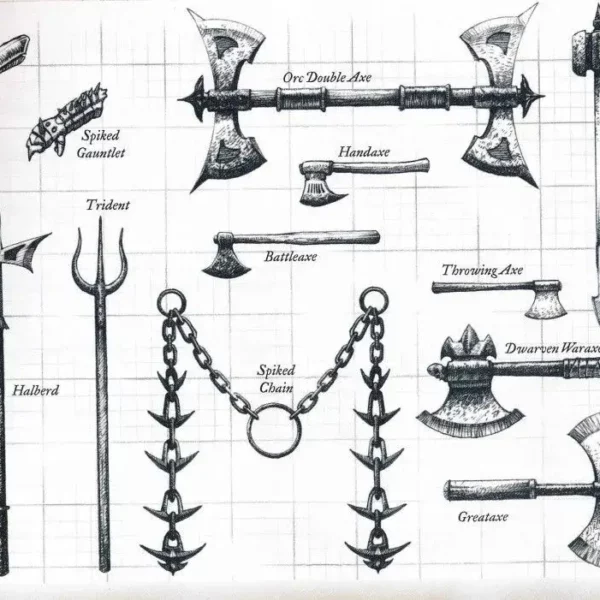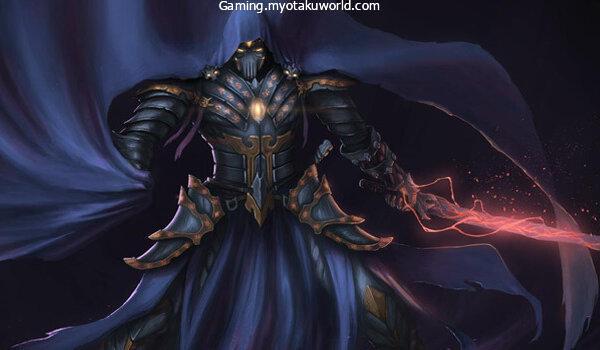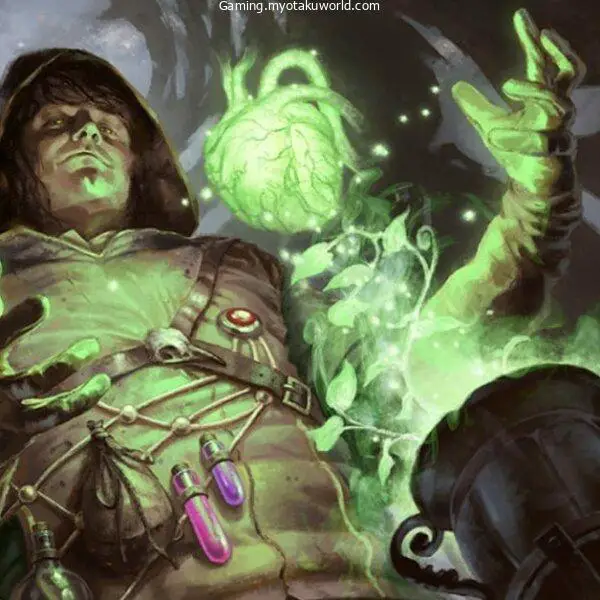As you’re strolling through the city, you come across a group of men beating a woman in an alleyway. You calmly enter and shout “Sinners! Stop this at once or your souls will find peace by Eldath’s hand.”
The muggers look at you with a vicious smile and then let the woman fall to the ground, still bleeding, and what if you make the same to me, holy lady? Let’s see what lies beneath that pacifist robe of span.
As she looks at you, the woman on the ground feels a surge of life as her body vibrates. A large, unidentified hand is behind you and is pushing the muggers against the wall of the alley.
The burglars are being slapped until they fall asleep. You stand straight. You clean the woman with magic and help her stand.
The hand continues to hit, and you smile as you go. Welcome to the Spiritual Weapon 5e Guide.
What’s it all about?
The PHB (Player’s Handbook), states that Spiritual Weapon is a 2nd-level spell. Casting time is 1 bonus action.
The range is 60 feet and the duration is 1 min. The components are Verbal and Somatic. The effect is as follows:
You create a floating, psychic weapon within your range. This weapon lasts until you cast the spell again.
You can use the spell to make a melee attack on any creature within 5 feet. The target takes 1d8 plus your spellcasting ability modifier force damage upon a hit.
You can move your weapon up to 20ft and attack another creature within 5 feet.
You can choose any form of weapon you like. The deities associated with a weapon (such as St. Cuthbert for his mace or Thor for his hammer), make this spell look like the weapon .”
The spell’s effect increases by 1d8 every 2 slots.
A breakdown of the spell’s characteristics

This spell is 2nd level D&D. It will be available to full casters around 3rd level. These levels have spells such as Enhance Ability, Aid, and Hold Person.
These spells are so reliable that they can deal damage to any encounter. However, Spiritual Weapon will not have the same impact in one encounter as hold person.
This spell uses pure energy to destroy enemies and it does.
This spell’s true potential is now, and he needs to make use of his action economy. This spiritual weapon can be used with Bonus Action, both when it is cast and later.
This makes it a great choice for bonus actions. This spell can be cast in one turn using a cantrip.
In subsequent turns, you can throw powerful spells with the action and deal 1d8+Wis each turn at virtually no cost.
It is just enough to reach 60 feet. To attack creatures flying or at long distances, you would likely use other spells and weapons.
This range allows you to attack almost any person in a room. It also grants you an attack that is likely to be further than the creature you are attacking.
This spiritual weapon can travel 20 feet per turn, which theoretically makes it even more powerful.
You can cast the components verbally and somatically with nothing in your hand. However, you must remember that it can’t be cast when you are restrained.
This is the second great feature of Spiritual Weapon. One-minute combat is ten turns, which is probably more than you would normally need.
But the best part about Spiritual Weapon is that it is concentration-free. Let this sink in. A stacking damage spell requires no concentration.
This spell can be used alone to lock a creature in a wall of force. It can be combined with all the concentration-based control spells to last an entire minute.
Dismantling the spell’s effects

Let’s start with the damage of the spell. 1d8 + ability modifier gives us 7,5 force damage per hit, which is based on a +3 Wisdom to a Cleric.
Although this isn’t much, we must remember that we have ten bonus actions to continue attacking.
This gives us a total damage output that is 110. This is a great feat in itself, but it’s even more amazing when you can make multiple attacks on different targets during combat without any downside.
The type of damage that is dealt is force. This is the most easily resisted in the game. Only the Helmed Horror is immune to this type of damage. Nothing else can reduce it. The weapon can cast spell attacks, meaning it can crit.
The spiritual weapon can be used to create other characteristics. However, it is not clear what these additional characteristics are. Tweet by Jeremy Crawford: “Some spells are drawn towards or harm only the lives force of creatures.”
The spell is a spiritual weapon and is intended to cause damage to living things. Does this mean it doesn’t damage undead or constructs? Good question.
Answer? The answer is yes. However, the DM might make an exception in his universe and always inform players about technical differences in advance.
Ideas for tasty killing
Let’s not forget about the weapon’s appearance. This is how the spell will look. If the deity is armed with a signature weapon, the spell will take that form.
The Hammer of Thor is an example. However, even if this is the case you should make sure the weapon looks the best for your character.
Every hammer is different. A hammer that is as big as a person’s head could be a huge hammer or a small, realistic Warhammer.
It could be described as a bow that launches a projectile instead of moving 20ft and then rematerializes wherever it lands. There is no limit and there are no better options than any other.
Keep in mind your race and lineage. A dwarven sword may not be the same as an Elven one. A dwarven spirit might be rougher than a Gnome. Your subclass. A war cleric might want a halberd.
A Divine Soul sorcerer may simply need some type of phantasmal power. It’s possible to add color to the spell by changing your character’s sentiments. For example, if you are angry it will be a red spear and when you get excited it will be a green maul.
Is Worthy?

It’s all very well but how do I access this devastating spell? First, the spell can be found on the Cleric Spells List, so any Cleric could use this spell at the 3rd Level. There are also Cleric Dominions that have it ready to use, such as the War and Life Domain Clerics.
The Bard is another option, with the Magical Secrets ability at 10th level. This allows them to choose any spell of any class. This ability is best used to select a higher-level magic spell.
However, the College of Lore Bard has the option to make this choice at the 6th-level, which allows him to grab lower-level spells at a lower cost. This spell can increase your damage if you have a front-liner bard with excellent dexterity.
The Oath of Conquest Paladin has a great way to choose a “Spiritual Weapon”. This spell is part of his oath spell lists. This spell is only available at the 5th level, which is two levels below the level where clerics would have received it.
Another downside is that Paladins have more things than his bonus action and have fewer spell slots. However, Paladins can still benefit from this type of offensive tool.
They have a ranged attack, which they often lack, and it is an increasing 1d8 + spellcasting mode per attack to the already front-line damaging bomb that is the Paladins.
The Divine Soul Sorcerers also have access to Cleric Spell List, which is always a positive thing.
This spell allows the sorcerer to use his bonus action sooner than any of his subclasses. They don’t have damage-dealing bonus action spells until level 5. This spell allows the Sorcerer to fight closer to their enemy. However, it won’t be a great option for him.
These are the monsters with Spiritual Weapons. These monsters all represent some type of religious authority in their respective cultures.
You could also give this spell to other monsters with that characteristic. This spell will give these monsters an action economy boost that is great for solo fights.
Three NPC sheets grant this ability: Priest, Cult Fanatic, and War Priest. All three of these NPC sheets have the “religious authority” characteristic. To give these NPCs flavor in combat, the DM may also use the “favored weapon of the god”.
FAQs
Can You Interact with Spiritual Weapon 5e?
Other than being moved by the spell caster and hitting creatures, the spell description doesn’t describe any other way to interact with the spiritual weapon. Jeremy Crawford tweeted, “A spiritual weapon doesn’t pass through walls.” It doesn’t also occupy its space. In other words, it isn’t designed to destroy foes.
Can you destroy a spiritual weapon 5e?
The spell states that the weapon will last for the duration of the spell or until it is cast again. Therefore, the weapon cannot be ended by anything other than a “Dispel Magic”. The spell does not contain concentration, so the spiritual weapon can be used until the end of the duration.
Does a Spiritual Weapon Cause Magic Damage?
A Spiritual Weapon is not a spell that does damage. It is force damage in this instance. The weapon also states that it targets creatures and no objects so it can’t be used as a normal weapon.
Final Words
Is “Spiritual Weapon” worth picking? Yes, it is. You can’t go wrong having more damage every round and at almost no cost, as we have already said.
This spell gives any cleric an attack that rivals their martial counterparts, while also allowing them to heal their allies.
It is also extremely easy to concentrate. This spell can be combined with Hold Person or Spirit Guardians, Insect Pest, and many other spells.
These spells have no negatives. They even stay up when you’re down. You don’t have to recast the spell if you do get up again. It may be difficult to run at 20 feet.
If they needed to, most creatures can outrun it easily. This spell works best if the battle is longer.
This spell could seem a bit lacking luster if it is fought for two rounds. That’s it. Enjoy this spell.









